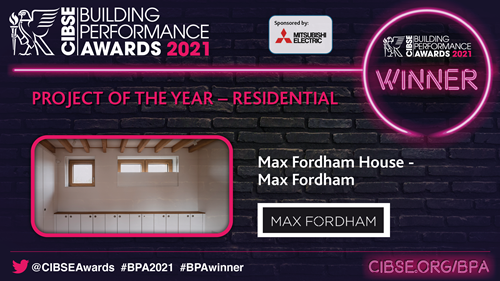
Project of the Year – Residential
Recognising and celebrating the new-build residential building that most effectively demonstrates high levels of user satisfaction and comfort while delivering outstanding measured building performance.
Winner: Max Fordham House – Max Fordham
This winning project’s design intent of zero heating impressed the judges, who were interested in the range of innovations and how they might be scalable and replicable to other projects.
Using the Passivhaus standard, the building was designed so the heat loss on a cold winter’s day would be no more than the heat generated by the people within. It was expected that a rooftop array of PV could meet the annual energy demands of the house.
The building – with its thermally massive structure, effective window opening areas, glossy white external finishes to window shutters and effective night-time ventilation – is also designed to stay comfortable in extremely hot weather. Its peak measured internal temperature was 28°C on 25 July 2019, when London reached 38°C during the record-breaking heatwave.
Building a new house on a small infill site along a narrow, cobbled mews brought spatial and planning constraints, however. Planted terraces were necessary to reduce overlooking to neighbours, but this meant a bigger thermal envelope and smaller roof area for the PV – ultimately thwarting the zero-heating aspiration.
After one year of occupation, the energy supply and demand were: space heating 2,253kWh; domestic hot water 1,836kWh; small power and lighting 2,217kWh; and PV generation 3,641kWh
The space heating demand is much higher than the project’s ambitions, partly because of the initial warm-up of the thermally massive house, which was completed in winter. Space heating is provided by a single 2kW electric heating coil in a common supply duct, controlled on return air temperature.
The judges noted the building’s maximisation of daylight and warm lighting. Occupied spaces are largely orientated south-east, which gives morning and midday direct sun, and a more characterful spectrum of light than diffuse daylight only. Artificial lights are generally off during the day.
Inclusivity aspects, and separation for ageing occupants, also impressed the judges. Plumbing connections have been built in so the upper part of the building could become a second dwelling should the ground floor become a self-contained flat without stairs. The flooring throughout is cork, which helps with acoustic character and offers some protection from falls.
Another plus with this project was the consideration of embodied energy, well ahead of current requirements.
Project Team
Building Services Consultant, Building Owner and Building Occupier: Max Fordham
Quantity Surveyor: e-Griffin
Architect: Bere Architects
Main Contractor: Bow Tie Construction
Shortlist
Highwell Passivhaus – David Cocking